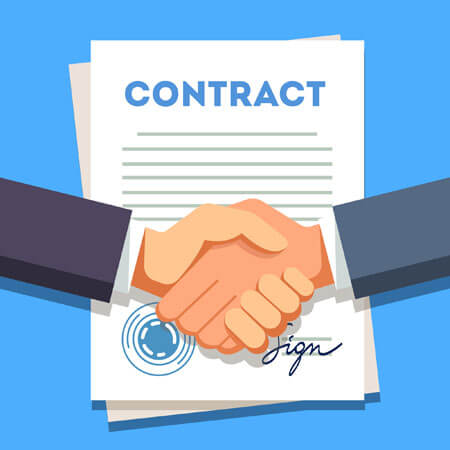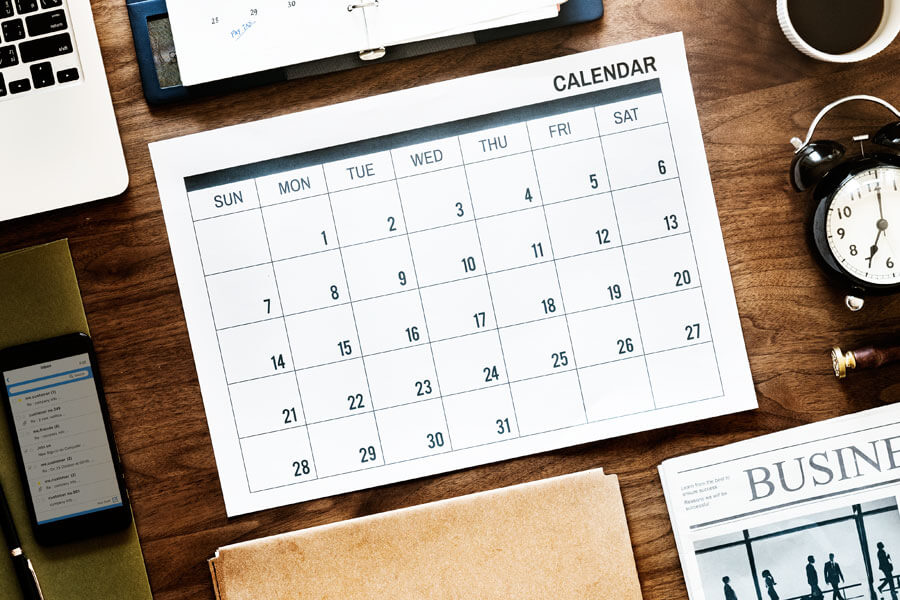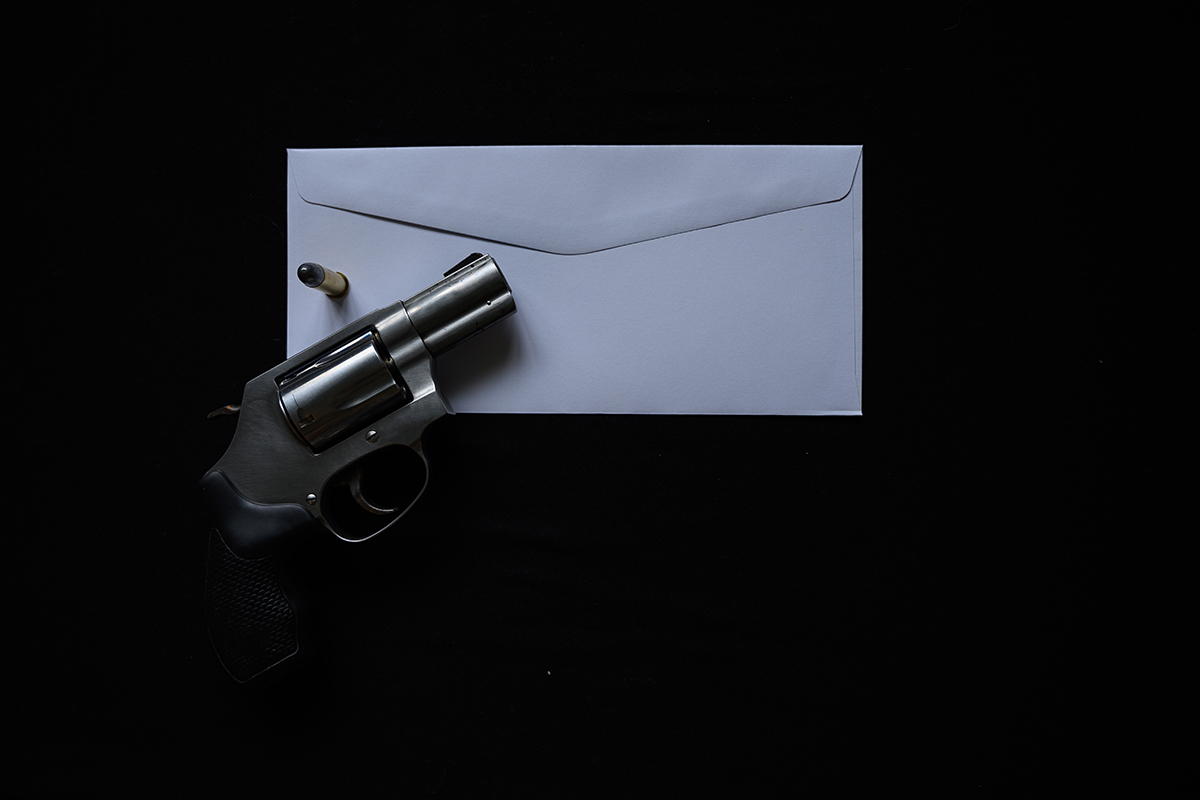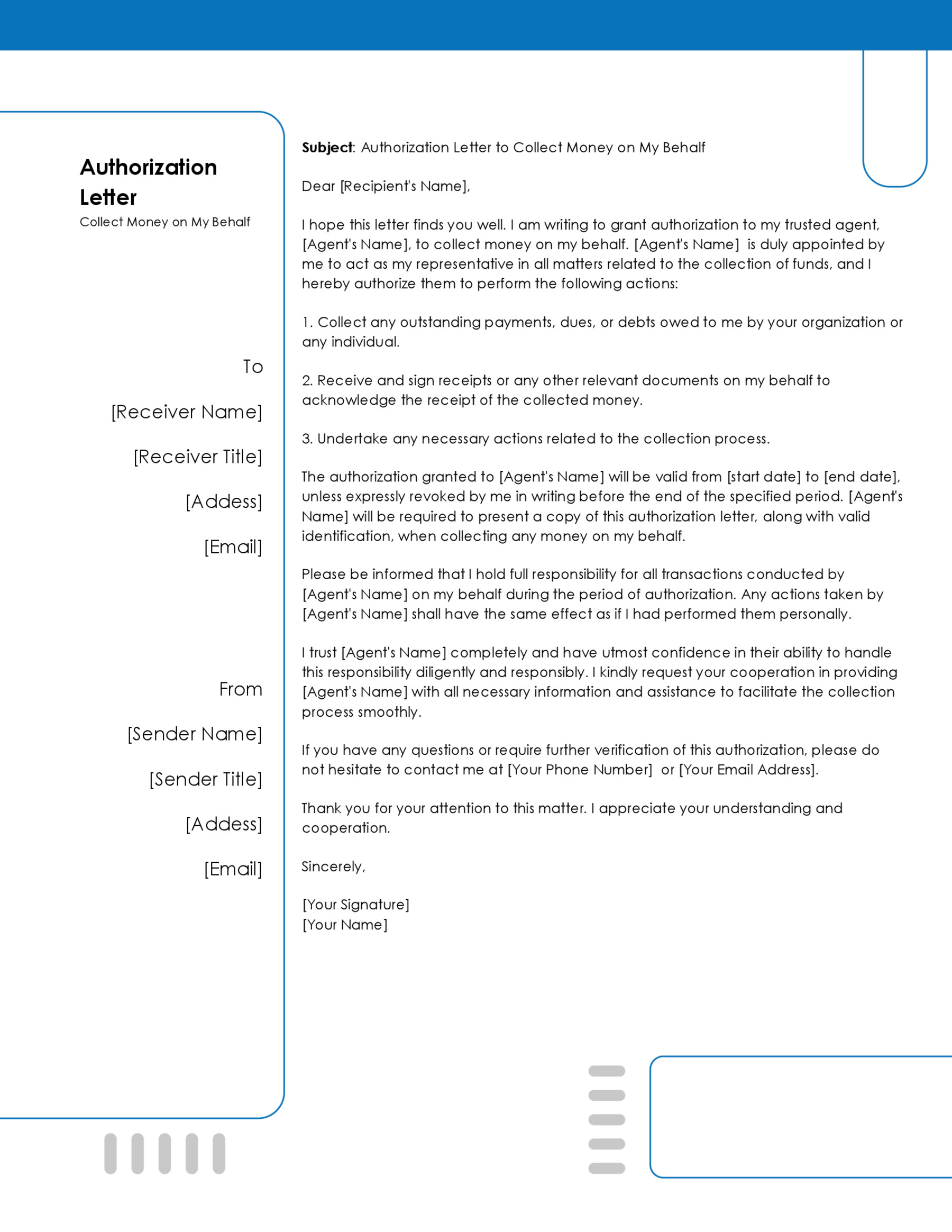An appointment letter for a meeting is a formal document requesting the attendance of an individual or a group of individuals at a scheduled meeting.
It is typically written by a manager or supervisor seeking to meet with a business partner, prospective business partner, client, or prospective client. Meetings are an essential aspect of daily activities as well as the decision-making process in an organization. To plan meetings for any purpose, an individual or organization would be required to draft and send out these letters to all the parties required for the meeting.
It aims to notify the recipient of the letter of an upcoming meeting and the essential details of the meeting. The time, venue, schedule, and other essential details are usually included in it.
Sample Letters
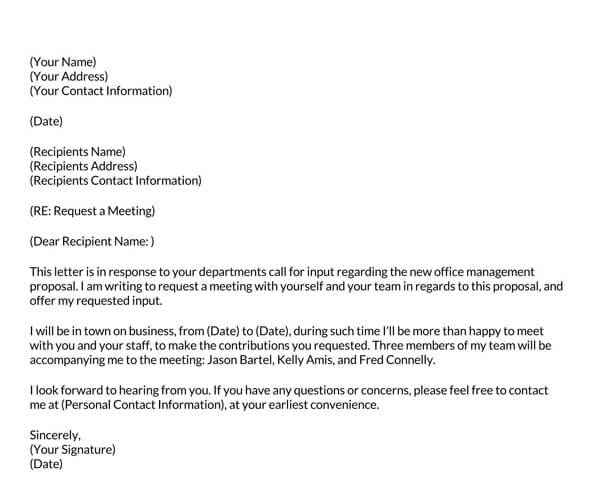
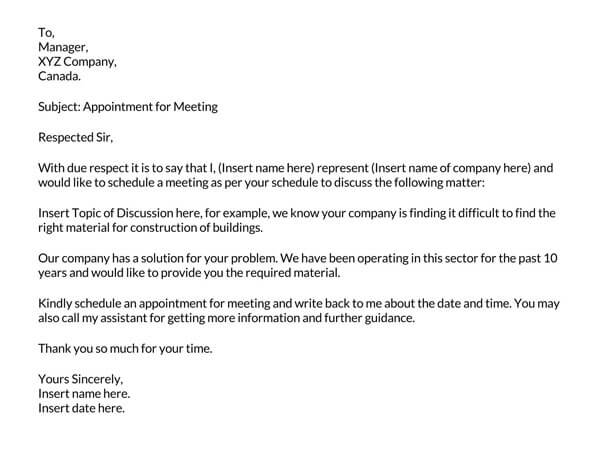
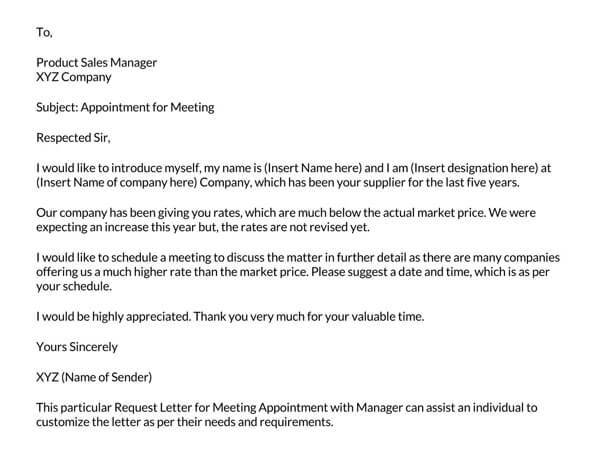
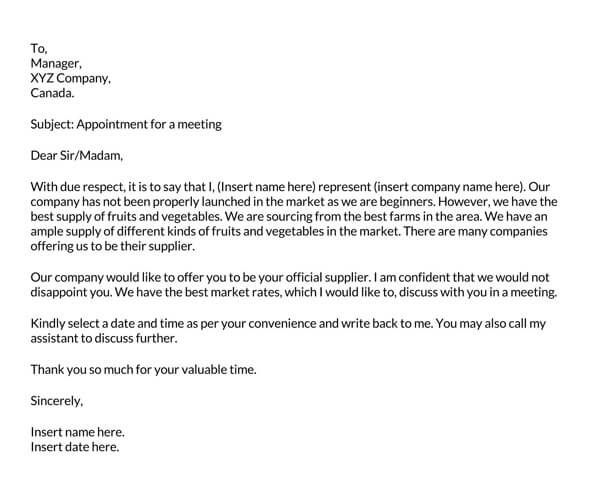
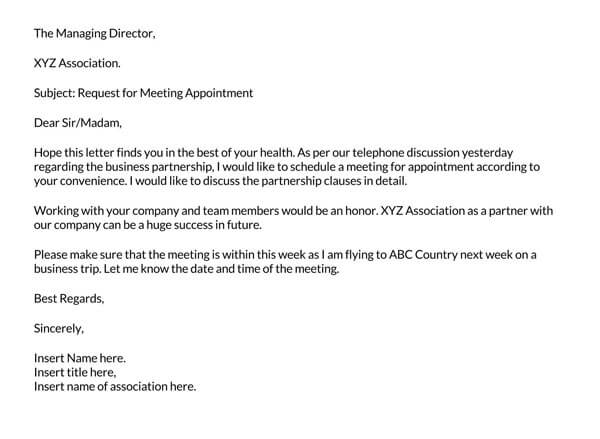
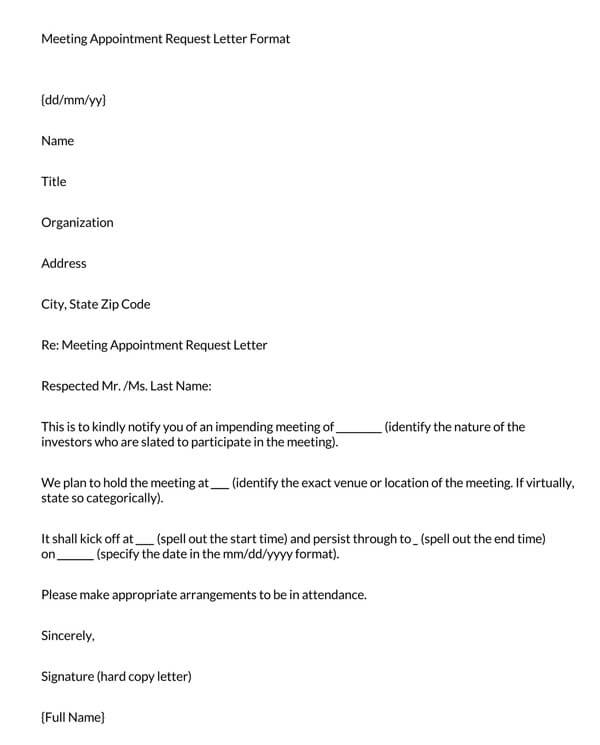
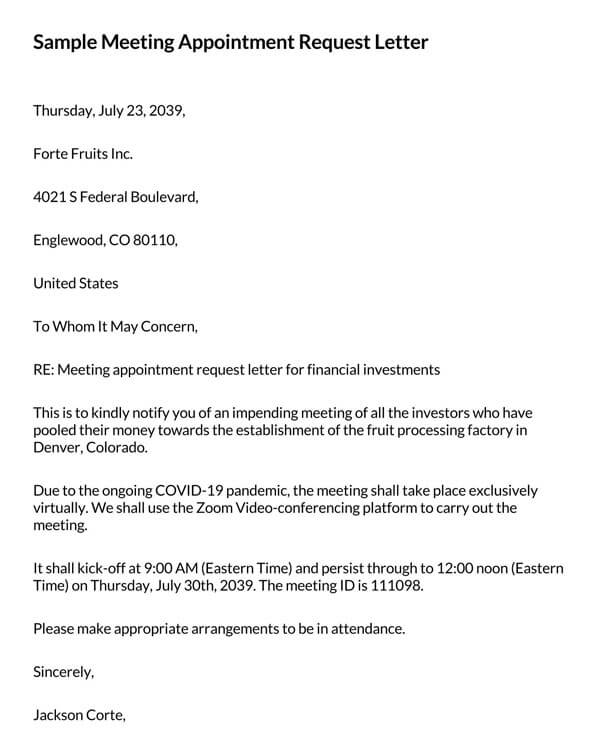
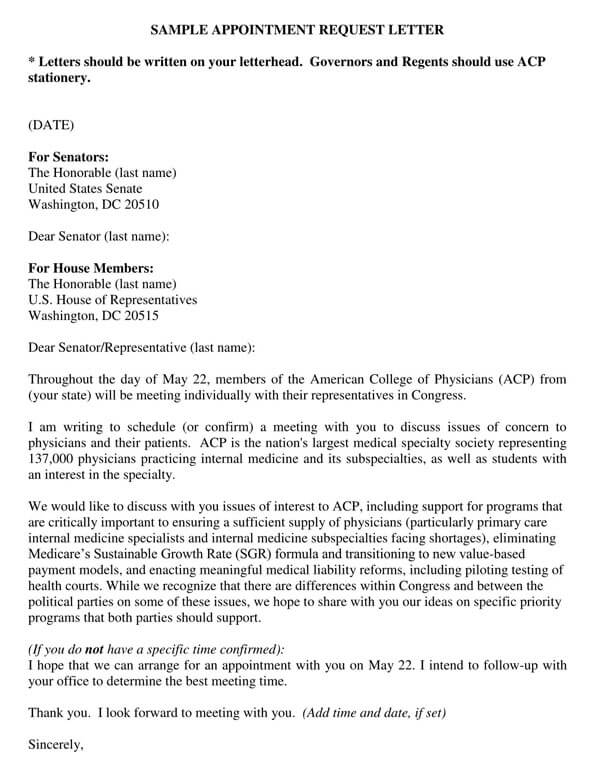

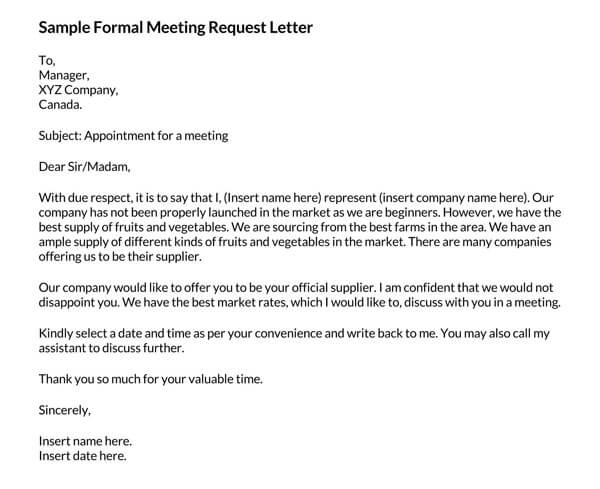
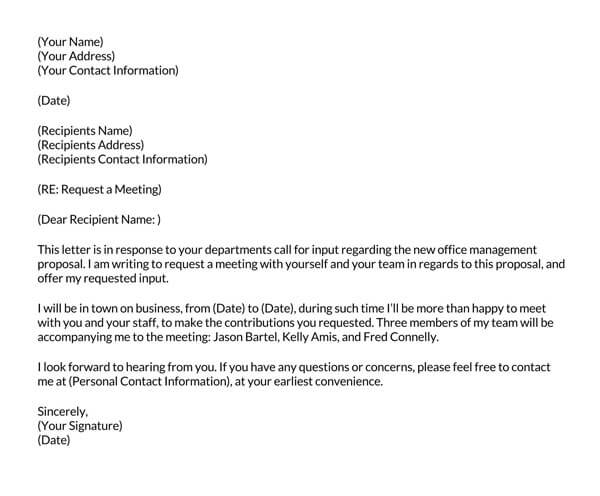
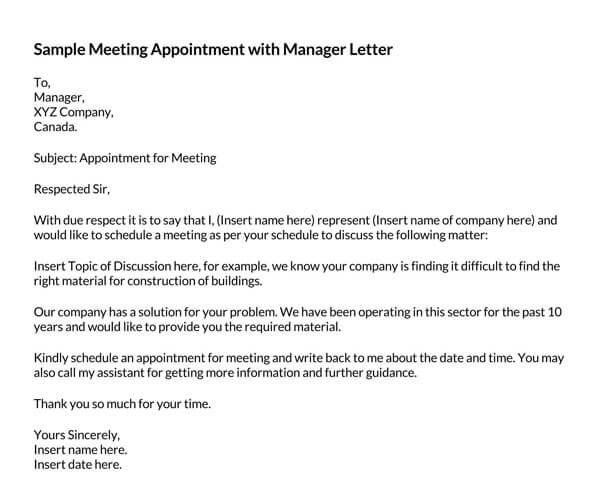
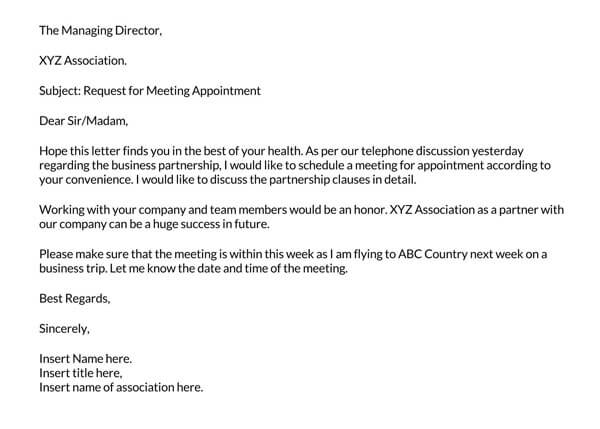
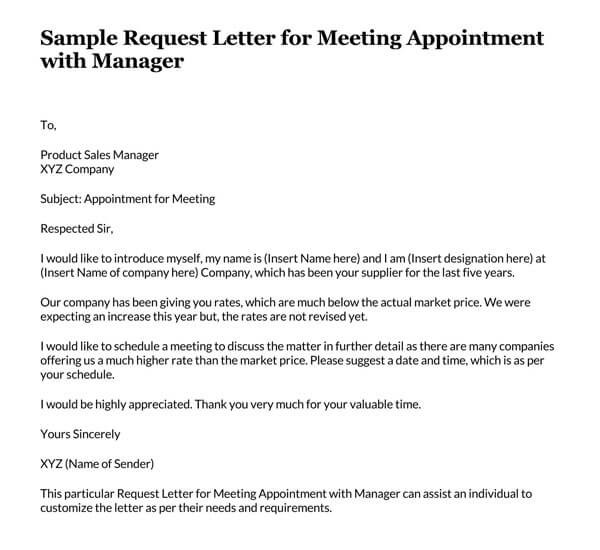
How to Write a Meeting Appointment Letter
It must be well written and include all critical elements to get the addressee’s interest and attention.
The steps for writing it are as follows:
Section 1: Choose a format
Before writing the first word of the letter, the first consideration for an individual or organization is its format.
When choosing the format, it is essential to note that the message in the letter must be clear and easy to read. Hence, choosing the right fonts and font sizes is essential in writing it. The sender of this letter should choose fonts large enough for the recipient to read easily without having to adjust the size or strain their eyes.
The sender should also refrain from selecting too large fonts, lest the letter look too long. The ideal length for it is one page. The ideal font size for clarity is between 14 and 16 points. Fonts that are most widely accepted for formal letters include Verdana, Times New Roman, Calibri, Cambria, Courier New, and Arial. Writing it in all capital letters often comes across as impolite and may also be quite difficult for the receiver to read.
Use letterhead
Using a letterhead quickly establishes the professionalism of the organization or individual drafting the letter. The letterhead also introduces the organization represented by this letter at first glance.
Business letter format
As it is a business letter, it should be written in a business letter format, primarily when it is written to schedule a meeting between two or more organizations to discuss business.
Section 2: Introduction
The introductory part should contain all the necessary elements of an introduction part of a formal letter. The sender should include the elements below:
Date
The date on which the letter was written should be written on the first line.
Receiver’s details
The details of the individual receiving the letter should follow the date on consecutive lines. The sender should include the following details:
- Name
- Title
- Organization
- Address
Commence with a salutation
A salutation is essential at the beginning of this letter. The salutation is used to address the recipient and, as such, must be official. An unofficial salutation is only acceptable if the meeting is going to be an informal one.
Place
After the salutation, the meeting venue should be specified for all parties involved, and a detailed address of the venue should also be provided.
Suggested dates and times
It must contain a proposed time and date for the meeting. While this time and date may be changed later to suit the schedule of all parties involved, it is ideal to propose a plausible time and date on the appointment letter for the meeting initially.
Length of the meeting
The length of the meeting should be proposed in it. The length of the meeting would better allow all parties involved to schedule a convenient time for the meeting. Ideally, a meeting should only be as long as is required to cover the plan and not a minute longer.
Since the sender has already decided on the agenda for the meeting, the sender can decide how many minutes or hours would be required to cover the agenda thoroughly. Once this is done, the sender can include this length in the letter to help the receiver work the time for the meeting into their schedule efficiently.
Section 3: Body paragraph
The body paragraph must contain the purpose and goal of the meeting. The body paragraph is the most crucial part of it, and hence, it should contain the core information about the meeting.
Therefore, the sender should include the following in the body paragraph:
Reasons for the meeting
The reason for which the meeting is scheduled to be held must be clearly stated. It must be an important and relevant one for all the parties involved. For instance, a manager may send it to a client to discuss a business proposal beneficial to both parties.
Benefits of attending the meeting
The benefits of participating in the meeting and the goals the meeting aims to achieve should be described in the body paragraph of the letter. A meeting between two or more parties should generally aim to benefit all parties involved. For example, if a manager requests a meeting with a prospective client, the benefit of the meeting should be focused on the opportunities both parties would gain by collaborating.
Section 4: Conclusion
The concluding paragraph should round off the letter with a summary of the meeting and other important details about the meeting. The sender should ensure that the following elements are included in the conclusion of this letter:
Request a follow-up
It is ideal to request a follow-up from the recipient(s) of the letter, as this will ensure that the scheduling is comfortable for both parties involved. It also ensures attendance.
Signatures
The sender is also required to attach their signature and the signatures of other relevant parties requesting the meeting.
Contact details
The sender’s contact details should also be included in the conclusion paragraph to facilitate easy follow-up and response from the receiver.
Free Template for Appointment Request Letters
[Your Full Name]
[Your Job Title]
[Your Company Name]
[Your Company Address]
[City, State, Zip Code]
[Your Email Address]
[Your Phone Number]
[Date: MM/DD/YYYY]
[Recipient’s Full Name]
[Recipient’s Job Title]
[Recipient’s Company Name]
[Recipient’s Company Address]
[City, State, Zip Code]
Subject: Request for Meeting – [Brief Purpose, e.g., Exploring Partnership Opportunities]
Dear [Recipient’s Name],
I hope this message finds you in good health and high spirits. My name is [Your Full Name], and I serve as [Your Job Title] at [Your Company Name]. I am reaching out to propose a meeting to discuss [briefly state the purpose, e.g., potential collaboration opportunities, project development, etc.] between our organizations.
Background and Purpose:
- [Provide a brief introduction to your company, highlighting any relevant achievements or specialties].
- The purpose of our meeting would be to [clearly state the meeting’s objective, such as exploring collaborative ventures, discussing a specific project, etc.].
- I believe that this meeting could be highly beneficial for both [Your Company Name] and [Recipient’s Company Name], particularly in [mention any specific areas of mutual benefit or interest].
Proposed Agenda:
- Introduction and overview of our respective companies.
- Discussion of [specific topics or areas of interest you wish to cover].
- Exploration of potential collaboration or partnership opportunities.
- [Any other specific points you wish to include].
Suggested Date and Time:
- I would like to suggest [two or three options for the meeting date and time], though I am open to any date that would be more convenient for you.
- I propose that we conduct the meeting [mention the mode – in-person, via video conference, or phone call]. If in-person, [suggest a location or ask for their preference].
Closing Remarks:
- I am confident that our discussion could lead to fruitful outcomes for both our companies.
- Please feel free to suggest any other date or time if the proposed ones are not suitable for you.
Your insights and expertise would be greatly valued, and I am eager to explore how our companies can benefit from this potential collaboration.
Thank you for considering this request. I look forward to the opportunity to meet with you. Please do not hesitate to contact me at [Your Phone Number] or via email at [Your Email Address] for any further information or to confirm the meeting.
Sincerely,
[Your Full Name]
[Your Job Title]
[Your Company Name]
[Optional: Attach any relevant documents, brochures, or project outlines related to the meeting’s purpose]
Formal Meeting Request Letter Samples
Sample 01
Subject: Strategic Partnership Discussion Opportunity
Dear Mr. Alexander Bennett,
I trust this message finds you thriving. I am writing to you as the Head of Business Development at Zenith Innovations, with an exciting proposal for a strategic partnership between our companies. Given Bennett Enterprises’ remarkable growth in the renewable energy sector and our recent advancements in sustainable technology, I believe a collaboration could be highly advantageous for both parties.
Zenith Innovations has been at the forefront of developing eco-friendly technologies, and we have closely followed Bennett Enterprises’ successful implementation of sustainable practices. We see a unique opportunity to combine our resources and expertise for a groundbreaking project in renewable energy.
I propose a meeting at your or our office in downtown Solaris City, with potential dates being the 20th to the 24th of March. Alternatively, a virtual meeting can be arranged if that suits your schedule better.
I am confident that this meeting could mark the beginning of a highly productive and mutually beneficial partnership. Your insights and leadership in the renewable energy sector would be invaluable in this collaboration.
Thank you for considering this proposal. I eagerly await your response and hope we can arrange this meeting soon.
Sincerely,
Liam Richardson
Head of Business Development, Zenith Innovations
Sample 02
Subject: Meeting Request for Future Project Collaboration
Dear Ms. Sophia Martinez,
I hope you are doing well. As your account manager at Orion Tech Solutions, I am reaching out to discuss how we can support your upcoming initiatives, particularly your exciting ‘Smart City’ project.
To understand the specific requirements and challenges of your ‘Smart City’ project, I would like to introduce our new Smart Infrastructure Solutions that could align with your project goals.
I am available for a meeting at your office in New Haven or via a video conference on the 15th, 17th, or 19th of this month. Please let me know your preferred option, and I will ensure everything is set up accordingly.
Your project is of great interest to us, and we are committed to providing the best solutions to contribute to its success.
Thank you for considering this request. I am looking forward to our discussion and to further strengthening our partnership.
Best Regards,
Ethan Walker
Account Manager, Orion Tech Solutions
Sample 03
Subject: Invitation for a Collaborative Discussion with Digital Dynamics
Dear Mr. Lucas Graham,
I hope this letter finds you in the best of spirits. My name is Isabella Torres, and I serve as the Director of Client Relations at Digital Dynamics. It has come to my attention that Graham Enterprises has been making significant strides in the digital marketing arena. Your innovative approach aligns well with our mission, and I am reaching out to propose a meeting where we can explore potential avenues for collaboration.
At Digital Dynamics, we pride ourselves on crafting cutting-edge digital solutions tailored to the unique needs of our clients. Given your company’s recent foray into advanced digital strategies, I believe a partnership could yield remarkable results for both of us.
I would be delighted to arrange a meeting at a time and place of your convenience to discuss this further. Whether you prefer a face-to-face conversation at your office in Emerald City or a virtual meeting, I am flexible to accommodate your schedule. I am particularly available in the first week of next month, but I am willing to adjust to suit your calendar.
This proposed meeting is more than just a formal introduction; it’s an opportunity to weave our expertise together for greater success. I am excited about the prospect of combining Digital Dynamics’ technological prowess with Graham Enterprises’ visionary marketing strategies.
I appreciate your consideration of this invitation and am hopeful for the opportunity to discuss our potential collaboration. I look forward to the possibility of joining forces for mutual growth and innovation.
Kind regards,
Isabella Torres
Director of Client Relations, Digital Dynamics
Analysis
These sample emails are effective because they demonstrate clear and concise communication, professionalism, and a tailored approach to each recipient. They begin with polite greetings and subject lines that clearly indicate the purpose of the communication, setting a positive tone from the outset.
Each email effectively conveys the sender’s understanding of the recipient’s industry or area of expertise, showing research and genuine interest in potential collaboration opportunities. By highlighting the alignment between the sender’s offerings and the recipient’s needs or goals, they establish a compelling reason for partnership.
Furthermore, the emails offer flexibility in terms of meeting arrangements, accommodating the recipient’s schedule and preferences, which shows consideration and a willingness to make the collaboration process as convenient as possible. Additionally, they express enthusiasm for the prospect of working together, creating a sense of excitement and possibility for future collaboration.
Overall, these sample emails effectively communicate the sender’s intentions, value proposition, and readiness for partnership, laying the foundation for productive discussions and potential collaborations.
Tips to Write an Effective Appointment Letter
As with most formal letters, it must be well-written, concise, and compelling enough to communicate the importance of the meeting effectively. Here are some tips for writing it effectively:
Conduct research on the client
It should aim to cater to the needs of the client. It is therefore essential for the sender to have significant, relevant information about the receiver. The sender should be able to identify the prospects of the industry in which they are operating and other struggles of the operators within the same industry, as well as the clients’ current interests.
Clearly state the reason for the meeting
The best approach for writing it is to state the reason for the meeting as concisely and clearly as possible in the letter. This approach is the easiest way for the sender to catch the receiver’s attention.
Keep the meeting appointment letter short
It should be written concisely. Hence, it should only be as long as it is necessary to convey vital information about the upcoming meeting. Because it is a formal letter, it should be brief yet concise enough that the recipient has all the vital information about the meeting on a single page.
Suppose this letter is meant to schedule a first meeting between the sender and the receiver (in this instance, the sender is unfamiliar with the receiver, and vice versa). In that case, the sender is not required to provide all the details in the first letter. Instead, the sender should state the benefits of the meeting briefly and concisely to gauge the receiver’s interest. More details can be provided in a follow-up letter should the receiver indicate interest.
Short sentences are ideal for a meeting appointment letter
When writing it, the sender should strive for clarity. The best way to ensure clarity and readability is to refrain from using overly long sentences in it. The sentences in this letter should be no longer than 30 words and should contain very few technical words or slang that may be difficult for the recipient to understand.
The meeting appointment letter should include a call to action
It seeks to persuade the recipient to attend an upcoming meeting. Hence, a call to action is a direct approach to engaging the receiver and getting the receiver to indicate interest. A good call to action can also be used to persuade the receiver to attend the meeting.
The sender can use a call to action like: “For further inquiry, don’t hesitate to get in touch with us by…” or “We would love to further discuss… with you via a phone call at your earliest convenience”. These call-to-action sentences allow the receiver to learn more about the upcoming meeting and answer any questions the sender may have omitted in the appointment letter.
The tone of a meeting appointment letter must be friendly yet professional
It is a formal letter; hence, the tone should be professional. However, the letter’s purpose is to persuade the receiver to attend a meeting with the sender, so the tone has to be persuasive and friendly. The best approach to achieving this is to keep the tone of the letter conversational yet formal. A conversational tone keeps the letter from sounding overly formal, yet it is engaging for the recipient.
There must be no typographical or grammatical error in a meeting appointment letter
It should conform to the standards of a formal letter. Hence, it must be free of any errors, both grammatical and typographical. The sender needs to double-check the letter’s content a few times to ensure that there are no mistakes, as mistakes may make a wrong impression on the recipient.
Valid documents should be attached to the meeting appointment letter
Depending on the purpose of the upcoming meeting, this letter may require specific attachments to bolster the message. Samples or brochures often serve to persuade the recipient of the letter to attend the meeting. When including attachments, the sender must mention the attachments in the letter. It is sent by email and should contain a sentence like “Attached are some samples of our work.”. If it is being sent through physical mail, it should contain a sentence like “Enclosed is our brochure” when mentioning documents attached to the letter.
Maintain politeness and courtesy
The tone throughout the length of the letter should remain courteous. The sender should use polite sentences and courteously describe the benefits of the meeting and the goals the meeting aims to achieve.
Format of Meeting Request or Appointment Letters
It needs to have the following elements:
The return address
Also known as the writer’s address, it should be placed at the beginning of the letter to the top left margin or the top right margin. This includes the name or institution writing the letter, physical address, town/ city, and zip code. All this should be written on separate lines ending with commas(,) after which one should skip a line to write the date. In this section, one should not include their telephone number.
The receiver’s address
This should be placed at the left margin, just below the return address. This may include the name, department of the institution, and title of the receiver, adding their address in full. One should not add the date after this address.
Salutation
As it is in many letters, the salutation is a formal way of greeting a person. This is “Dear Mr.” or “Dear Mrs.” followed by the name of the person, ie: “Dear Mr. Blake.”. This should be completed with a comma. It is advisable not to use “Dear Mr” or “Dear Mrs” separately unless you are aware of the gender of the receiver.
The main body
The body of the letter comes next and this contains the reasons for writing it. This may be in three to five paragraphs, containing five to six lines each. The paragraphs can be in block or indented format.
The body should contain the venue of the meeting, a concise and brief description of the reason for the meeting, the date of the appointment, the suggested meeting duration, the date of a possible follow-up meeting, and what the people attending may gain from the meeting. To gain a reader’s attention easily, one may consider using phrases such as “Please note that”, “Please consider,” etc
Conclusion
One may close with “Yours Sincerely.”. This is written at the bottom left of the page, after which you leave a space for a signature followed by the writer’s name.
Some writing tips for appointment letters are as below:
- The length of the letter should be at least one page.
- The language used in the letter should be simple and not use any broken words.
- The letter should have no errors, as one should check for grammatical errors, spelling mistakes, and punctuation errors.
- The letters should be typed to avoid dirty work presented through handwritten letters.
- Although it is modern to send letters via email, it is more official to print and present the letters physically.
- One should use a standard piece of paper in their country/ region and for proper delivery, one should consider using a manila envelope to ensure the letter arrives intact.










